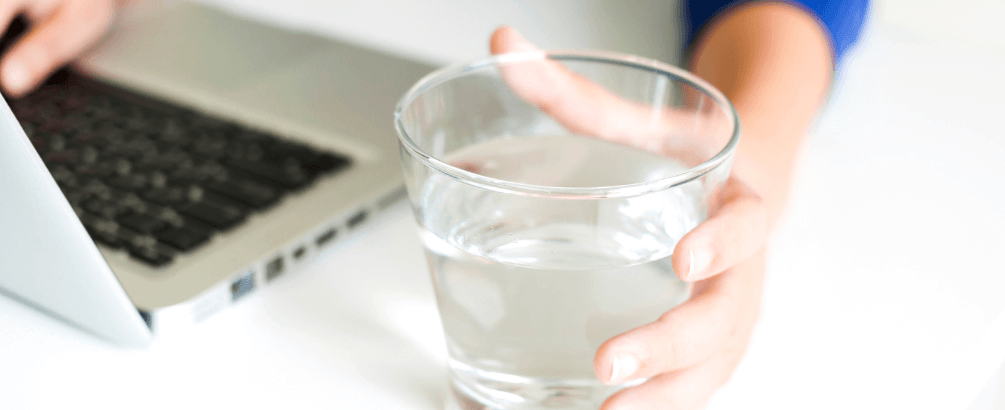- [7-stage filtration] The G2P600 reverse osmosis system adopts a composite filter technology, which can reduce most contaminants. The CF filter can reduce rust, sediment, and organic matter. The MRO filter uses a 0.0001-micron reverse osmosis membrane to intercept TDS, salt, PFAS, fluoride, heavy metals, etc. Our RO system can reduce toxic chemicals such as vinyl chloride, ethylhexyl acrylate, isobutylene, and ethylene glycol, according to the reverse osmosis membrane technical manual.
- [600 GPD] Waterdrop G2P600 tankless reverse osmosis system produces 600 gallons of filtered water per day. With a fast and stable water flow rate, this RO system fills a 200ml cup with water in 8 seconds, which is ideal for drinking, and washing vegetables and fruit.
- [2:1 pure to drain ratio] G2P600 tankless RO system reduces your replacement cost and upgrades the water-saving technology with a drain ratio of 2:1. Dispensing 2 cups of pure water will produce only 1 cup of wastewater.
- [Superior product design] This tankless reverse osmosis water filtration system saves 70% of your under-sink space and prevents recontamination. You can finish the installation by yourself in 30 minutes. Due to the filter’s twist-and-pull design, you can change a filter in 3 seconds without moving the system or using any tools. In addition, the filter life indicators will remind you to replace the filter in advance.
Waterdrop G2P600 Remineralization RO Water Filtration System for Home
Model number
WD-G2P600-W
Item weight
20.94 pounds
Materials
1. System cover: BPA-free plastic
2. Faucet: metal
3. MRO filter: reverse osmosis membrane & sediment PP membrane & activated carbon block & PET pleated membrane
4. CF filter: sediment PP membrane & activated carbon block
Power cord length
59 inches
Product dimensions
17.3×5.9×13.9 inches
Feed water pressure
14.5-87 psi / 0.1-0.6 Mpa
Indoor or outdoor use
Indoor use only
Components Included
System cover, brushed nickel faucet, feed water adapter, MRO filter, CF filter, PE tubing*3 ( 60" ), drain saddle, lock clip, teflon tape, main power cable ( 59" )
Wall plug
Yes
Usage conditions
Ice machines, Faucets, Aquariums, RVs, Well water
*If you use well water as the source, please ensure that the feed water is pre-filtered.
An electrical outlet is required to operate the RO system.
What is reverse osmosis water filtration system for home?
How does a reverse osmosis water purifier work?
What does reverse osmosis water filtration system remove?
Is this reverse osmosis water filter system unit suitable for well water?
The reasons are as follows:
1. Large particles.
Compared to municipal tap water, the well water is rich of large particles, which will clog the filters easily, and shorten their lifetime significantly.Please note that the filters will still need to be replaced more frequently, even if you have added a pre-filtration system.
2. Composition
The well water has very complicated compostion, and some of them (apart from the large particles) can cause the filter or internal valve to be clogged and prevent the RO system from normal performance.
3. Water pressure
The well water may not provide the feed water pressure that the RO system requires (14.5 psi min.). Furthermore, the water pressure will be even lower after passing through pre-filtration systems.
Where to buy reverse osmosis water filter?
How much water does reverse osmosis waste?
How much does a reverse osmosis system cost?
How often do I need to change the RO filter?
How to install Waterdrop reverse osmosis system?
What is the lifetime of a reverse osmosis water filter?
How long is the power cord of the RO water purifier?
How many stages of filtration does this system perform?
Does this RO filter come with everything needed for install?
Do you have to use the faucet that comes with this system?
Will work with instant hot/cold water device?
How loud is the pump of the reverse osmosis water filtration system?
Can I use our own faucet?
You could use your own RO faucet with our product, but not normal faucet for tap water.
There are a few things you may need to know before purchasing one:
Firstly, our faucet is equipped with a filter life indicator, which allows you to monitor the filters' life easily. If you decide not to use our original faucet, this function will not be in effect.
Secondly, your RO faucet should be able to connect with the outlet tubing of the system, which has a diameter of 1/4".
In addition, it should have a "Quick-Connect Fitting", please click here.
OR, it should come with a set of accessory parts, which allows you to connect the faucet with the bare end of our outlet tubing. Please click here to see the example for your reference.
If the faucet does not meet one of these requirements, you will need to acquire a corresponding adapter, in order to complete the connection with the machine.
What does Pure to Drain Rate mean?


- First sediment PP membrane: Reduces rust, sediment, suspended solids, and other large particles.
- Premium activated carbon block: Reduces chlorine, organic matter, taste and odor, etc.
- Second sediment PP membrane: Reduces rust, sediment, suspended solids, and other large particles.
- 0.0001-micron high-precision reverse osmosis membrane: Reduces TDS, lead, salt, atrazine, fluoride, nitrates, PFAS, bacteria, etc.
- Post activated carbon block: Reduces taste and odor and improves the taste of water.
- Remineralization filter MNR35 adds 18 natural minerals in to water, including calcium, magnesium, sodium, potassium.


- This reverse osmosis system comes with an external RO remineralization filter to add beneficial minerals.
- 18 natural materials are adopted to restore minerals. You will benefit from RO mineral water in the long run.


- Enhance bones: Improve bone health and help prevent diseases such as reducing post-menopausal bone density.
- Lower bad cholesterol: Lower harmful cholesterol with magnesium and potassium content.
- Promote digestion: Help digestion by increasing the amylase secretion from the pancreas with its sulfate content.
- Improve skin: Rich mineral content moisturizes the skin and delays wrinkles.


- Dispensing 2 cups of pure water will produce only 1 cup of waste water.
- Compared to traditional RO water purifiers with a water tank, the G2P600 reverse osmosis system saves 600% more water.
- Please refer to this diagram and be informed that you need to drill a hole on your countertop to place the smart faucet (No need for this step if your countertop already has a hole).
- Besides, an adapter will be installed on your household water tubing to connect to RO system’s wastewater tubing and input water tubing.
- Electricity is required to run the RO system.
- We do not recommend using well water as source for our RO systems. We do not recommend connecting tankless RO to a refrigerator or ice maker.
- It's highly recommended to install our RO system with components provided by Waterdrop. Installing the system with any parts or accessories that are not provided by Waterdrop may cause the system to malfunction or shorten the lifetime of the system/filters.




- Compared to traditional water purifiers, the G2P600 Reverse Osmosis Water Filtration System has automatic water shut-off valves and fewer connectors, which reduces the risk of water leakage.
- This system’s noise does not exceed 55dB, which is a safe noise level for everyday life.

Remineralizatio G2P600 RO Filtration System |

Remineralization G3 RO Filtration System |

Remineralizatio G2 RO Filtration System |

Remineralization D6 RO Filtration System |

Remineralization G3P800 RO Filtration System |

G3 RO Filtration System |
|
| Need Installation | √ | √ | √ | √ | √ | √ |
|---|---|---|---|---|---|---|
| Beneficial Minerals | √ | √ | √ | √ | × | × |
| Flow Rate | 600 GPD | 400 GPD | 400 GPD | 600 GPD | 800 GPD | 400 GPD |
| Pure to Drain Rate
Drain ratio stands for the
ratio of wastewater and
purified water dispensed by a RO system. For example,
the 3:1 drain ratio means it uses
up a gallon of wastewater for every 3 gallons of pure
water you get.
|
 |
 |
 |
 |
 |
 |
| Faucet | Ordinary faucet | Smart faucet | Ordinary faucet | Smart faucet | Smart faucet | Smart faucet |
| Display | Filter lifespan | Filter lifespan & TDS | Filter lifespan | Filter lifespan & TDS | Filter lifespan & TDS | Filter lifespan & TDS |
| Self-clean | × | √ | × | √ | √ | √ |
| Holiday mode | × | √ | × | √ | √ | √ |
| Electricity Required | √ | √ | √ | √ | √ | √ |
| Filter Cartridges |
WD-MNR35 WD-G2CF WD-G2P6MRO |
WD-MNR35 WD-G3-N1CF WD-G3-N2RO WD-G3-N3CB |
WD-MNR35 WD-G2CF WD-G2MRO |
WD-MNR35 WD-D6RF |
WD-MNR35 WD-G3-N1CF WD-G3P800-N2RO WD-G3-N3CB |
WD-G3-N1CF WD-G3-N2RO WD-G3-N3CB |
| Noise(≤) | 55dB | 65dB | 55dB | 55dB | 65dB | 65dB |
| Filter Lifespan | CF-12 Mths P6MRO-24 Mths |
CF-6 Mths CB-12 Mths RO-24 Mths |
MNR-12 Mths CF-12 Mths MRO-24 Mths |
12 Mths | MNR-12 Mths CF-6 Mths CB-12 Mths RO-24 Mths |
CF-6 Mths CB-12 Mths RO-24 Mths |
| Dimensions(inch) | 17.32*5.91*13.9 | 18.06*5.68*17.76 | 17.32*5.91*13.9 | 15.98*5.98*11.97 | 18.11*5.67*17.72 | 18.11*5.67*17.72 |

- The 2-in-1 composite filter uses a natural activated carbon block and a sediment PP membrane.
- Provides you with 12 months or 1,100 gallons of clean filtered water.
- You can replace the filter in 3 seconds with a single twist. No tools are required.

- Provides you with 24 months or 3,300 gallons of clean filtered water.
- You can replace the water filter in 3 seconds with a single twist. No tools are required.
- The composite MRO filter adopts a sediment PP membrane, 0.0001-micron.

- An excellent add-on Remineralization filter adopts 18 natural materials to restore minerals.
- Saves 8300 single-used bottles and $12600 spent on bottled mineral water.
- Compatible with RO water system, undersink filtration systems and refrigerator.
Thank you for subscribing!
We are thrilled to have you on board and look forward to sharing exciting updates, exclusive offers, and valuable insights with you.































































































































